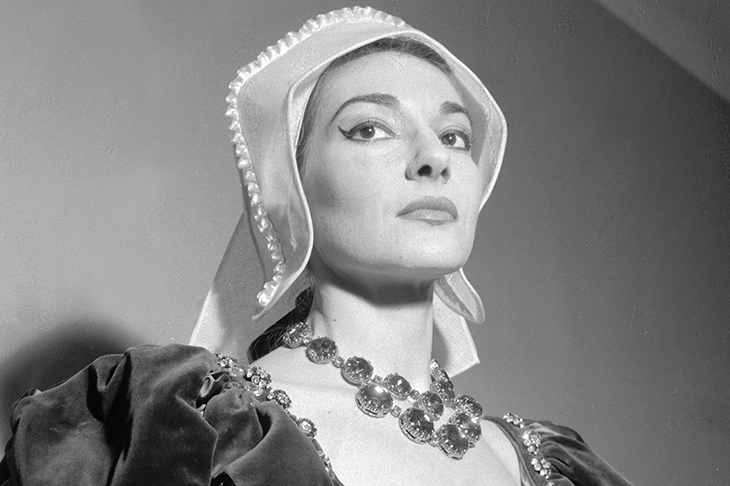Anyone who thinks that an artist’s life is irrelevant to their artistic achievement, and for that matter anyone who thinks that it isn’t, must be given pause by Maria Callas. It is now exactly 40 years since her death and everything she recorded is available on multiple pressings. But of the huge body of material that has appeared about her, only a small percentage concerns itself with the recordings. There are innumerable biographies, memoirs, refutations of memoirs, studies of the influence of her fluctuating erotic life on her singing, her meteoric rise, the Great Decade, the tragic decline, and so on. All of these might be fascinating, but they draw attention away from the only thing that mattered about her: her art. Even when discussion homes in on her voice, it tends to be on whether she was a pushed-up mezzo, whether her unique sound was the result of a gothic arch-shaped roof of the mouth, and so forth.
The first and most decisive way to counter all that fascinating irrelevance is to put on a CD of her in a full operatic performance, or in a recital, and see what effects it has. They are, for a sensitive listener, likely to be immediate and powerful. To commemorate her death Warner is issuing a large and sumptuous box set of her ‘live’ performances, beginning with Verdi’s Nabucco in 1949 and ending with Covent Garden’s Tosca in 1964, together with three Blu-ray discs of Maria Callas in Concert, including two versions of the Act Two of Tosca, tragically the only complete operatic act in which she was filmed, and extended excerpts of interviews.
All this material has been issued before, but Warner’s engineers have used an advanced system of sound enhancement, and these transfers are mostly in considerably better sound than they have been before, though in some cases a high degree of tolerance is required. Since I spent much of my time in the RAF attempting to decipher signal from noise, listening in to Russian pilots communicating — or failing to — with one another, I find this no strain, but hi-fi devotees may.
So, leaving or attempting to leave on one side questions about how one performance of, say, La traviata differs from another, though that can be interesting and even relevant to experience and judgment, what makes the impact of Callas so extraordinary, unrepeated and unrepeatable? In a nutshell, she was not only a re-creative but a co-creative artist. She took the notes offered to her by the composer and made them her own in a way that is unique in its scale and depth — whole roles emerge as new when she sings them. Many of her roles seem to me to be in second-rate, or anyway less than great, operas and, like all creative artists, she has her fluctuations in achievement, but she is always recognisable — instantly — and she frequently imbues the commonplace with an inflection that turns it into a revelation. Other singers and instrumentalists and conductors do that too, but Callas does it on a scale and with an intensity that mark her out as unique in her field.
It is significant that she sang little Mozart and was not inclined to sing more. A composer on his transcendental level of achievement can only be more or less adequately interpreted: enhancement of his work is not a possibility. Callas did record a few Mozart arias in one of her later recital discs, but they sound routine. Though she professed, in one of her reginal interviews with Lord Harewood, which is on DVD, that she always began with a profound respect for the music she was to sing, she actually, in all her greatest performances, takes it and makes it new, as any really significant performing artist does. What makes Callas unique is the degree to which she transformed a role, above all her two signature roles, as Norma and as La traviata — in the latter work to a point where I can’t find any interest in anyone else singing the title role. By the time Callas began to develop her interpretation of it, Norma was regarded as antiquated. But thanks to her, and with only moderate support from her colleagues (until Christa Ludwig joined her in a 1960 commercial recording), it became a tragic masterpiece to rank with any other work in the Italian repertoire.
The earliest works in this new set are Gluck’s Alceste and Ifigenia in Tauride, the first well conducted by Carlo Maria Giulini. Callas’s intensely dramatic approach to the title roles is unfortunately not shared by her colleagues, but once again she shows her instinct for intense communication in every phrase. So does she in the one Wagner opera of which her interpretation survives, and which is on the Warner set in decent sound: Parsifal, though with many cuts and sung in Italian by a mainly non-Italian cast. Kundry, Wagner’s most complex female character, is, in Callas’s throat, not surprisingly very seductive, and Callas has no difficulty with the ungainly vocal writing. But it gives her no scope for the creation of character, which remained her gift to the end of her career, even when she sings an aria. Watch her performance in Hamburg of Verdi’s ‘Tu che la vanità’ from Don Carlo, and see whether you don’t find out more about Elisabetta than in most full stagings of the opera. If you look for the things that vocal pundits insist on — steadiness of emission, smooth movement between the registers, and so forth — you will lament that Callas had them and lost them or never really had them. Considerations of beauty in the most simple sense were never her concern, though she didn’t disdain them. But if truth to the nature and depth of feeling — whatever exactly that comes to — are what you want, then you will get them from Callas in a way that no one else provides.






Comments